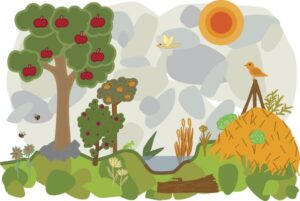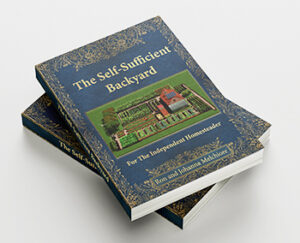Introduction
Permaculture Principle Ten, ‘Use and Value Diversity’, underscores the significance of diversity within an ecosystem. This principle asserts that diversity leads to vitality, resilience, and productivity in an ecosystem, much like a well-balanced investment portfolio.

Understanding Diversity
In the context of permaculture, diversity refers to the variety of plants, animals, and microorganisms within a system, as well as the interactions between them. It’s about more than just the number of species; it’s about the complexity of their interactions and relationships. The greater the diversity, the more robust the system. The lack of diversity in monoculture farming has resulted in the need for chemical fertilizers and insecticides.
Even monoculture farmers have begun to understand the need for things such as cover crops to add biomass and fertility back to the soil. Some monoculture farmers have begun to set up beehives to assist in pollination and provide a side business of honey making.
Benefits of Diversity
Diversity is key to resilience. A diverse ecosystem is better equipped to withstand and recover from various threats, including pests, diseases, and changes in climate. Each species in a diverse system has a unique role to play, contributing to the overall health and balance of the ecosystem.
An example of this might be ginseng. Ginseng is grown as a mono-crop in some places. However, you can’t replant in the same place as successive crops will become weaker and weaker. This requires finding new land continually.
In the wild, ginseng has grown in colonies for hundreds of years coming up over and over in the same place. But in the wild, it is not a monocrop. It is grown with many other plants around and in the colony. Some studies suggest it may be this diversity that enables ginseng to reseed and grow in the same place in the wild.
Practical Applications
Applying this principle to a permaculture design involves incorporating a wide range of different plants, animals, and beneficial insects.
This could mean planting a variety of crops rather than a single type such as monocropping. It could also mean creating a diverse habitat that supports different species of wildlife.
In addition, this principle encourages utilizing a wide range of techniques in a permaculture design such as companion planting, using natural pest control methods, and adding features like swales and ponds to attract beneficial insects.
It might also mean introducing chickens who can provide eggs and meat as well as compostable fertilizer from their bedding. Chickens can also do bug control in the garden decreasing the cost of feeding them. You can feed chickens your leftover vegetables and decrease waste and your feed bill.
Adding bees can provide honey, and wax, and pollinate your garden. As an added bonus you will be supporting the honeybee whose populations are decreasing possibly due to the use of pesticides.
Planting flowers that attract beneficial insects can decrease the need for pesticides. Companion planting is a well-known way of increasing yield as companion plants help one another in various ways An example might be planting a ‘guild’ – a group of plants that work well together, like corn, beans, and squash, the traditional ‘Three Sisters’ guild of the Native Americans. The beans provide nitrogen for the soil, the corn provides a trellis for the bean and the squash shades the ground increasing water retention for all three plants.
Case Studies
A real-world example of Principle 10 in action can be seen in the permaculture gardens of Zimbabwe, where farmers plant a mix of maize, pumpkins, and beans, instead of monocultures. This practice not only improves the health of the soil and yields but also reduces the risk of crop failure due to pests or disease.
Another example is the permaculture system at the Lama Foundation in New Mexico, which is composed of a diverse range of plants and animals, including goats, chickens, bees, and various fruit trees. All these different elements form a resilient and self-sustaining system that can provide food while also providing other benefits such as habitat for wildlife.
The use of diverse permaculture can also be seen in urban settings, such as edible gardens in public parks or community gardens that grow a wide range of fruits and vegetables. Such initiatives provide access to fresh produce while promoting biodiversity and creating educational opportunities for the local community. By incorporating principles like Principle 10 into their designs, these urban permaculture projects can help create a more sustainable and resilient future.
Finally, the use of diverse permaculture principles can also be seen in home gardens. Planting a range of vegetables, herbs, and flowers not only looks great but also creates an environment that is self-sustaining and full of life. It’s also a great way to reduce the environmental impact of food production, as well as provide a source of healthy and delicious produce.
By applying Principle 10 to our lives and landscapes, we can create sustainable systems that will support us now and in the future. Diverse permaculture is an important tool for creating resilient ecosystems that are beneficial to both people and nature. With careful planning and design

Conclusion
In conclusion, diversity is an invaluable asset in permaculture, leading to resilience, sustainability, and productivity. By embracing diversity, we can create abundant, healthy, and resilient systems that are better equipped to adapt to change and thrive. Principles such as Principle 10 are essential to the success of permaculture projects, allowing us to create systems that benefit both people and nature. By incorporating diverse permaculture into our lives and landscapes, we can create a better future for generations to come.
Diversity in permaculture is not only a practical solution but also an ethical responsibility. As we strive for sustainability, it’s important to remember the true power of diversity: it can provide us with the solutions we need to create a future that is both sustainable and full of life.
For more on permaculture principles check out my article permaculture principle one here.
Permaculture principle nine is here.
Permaculture Principle eleven is here.
What is permaculture is here.
